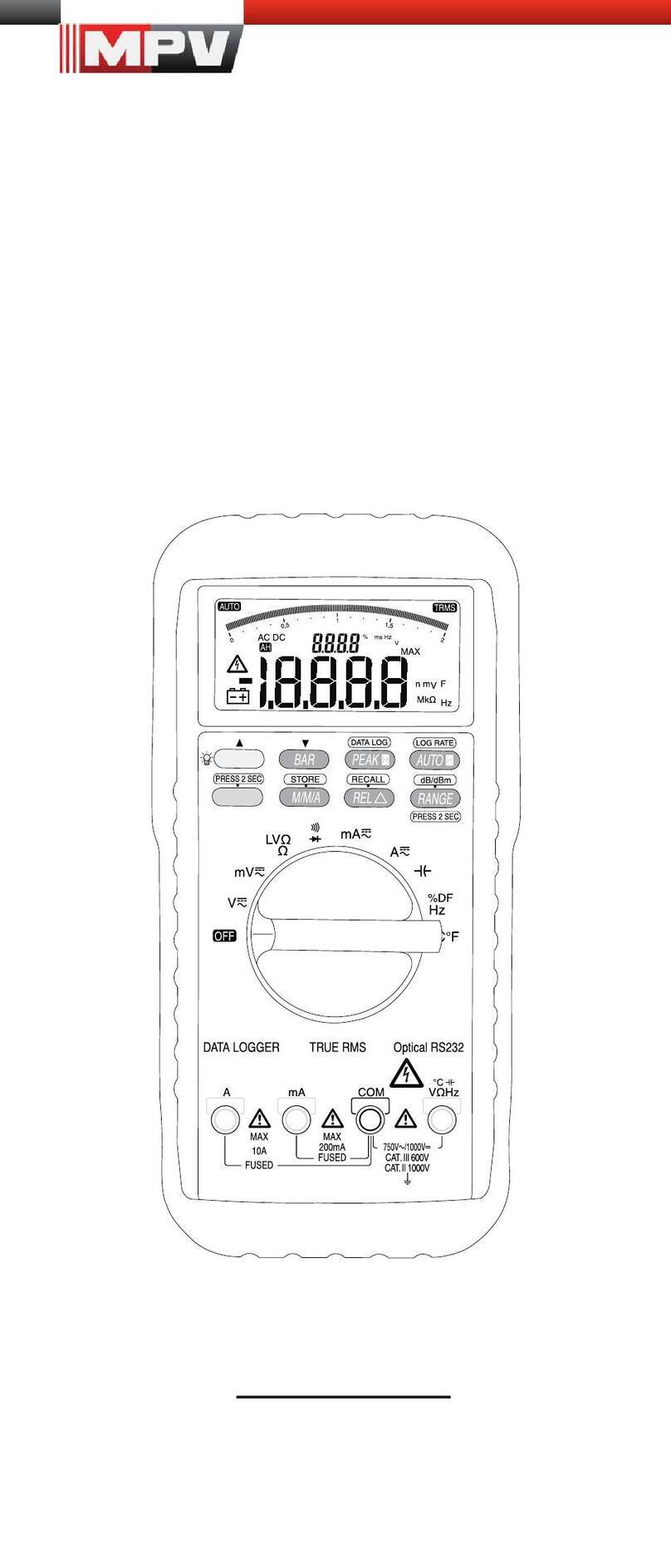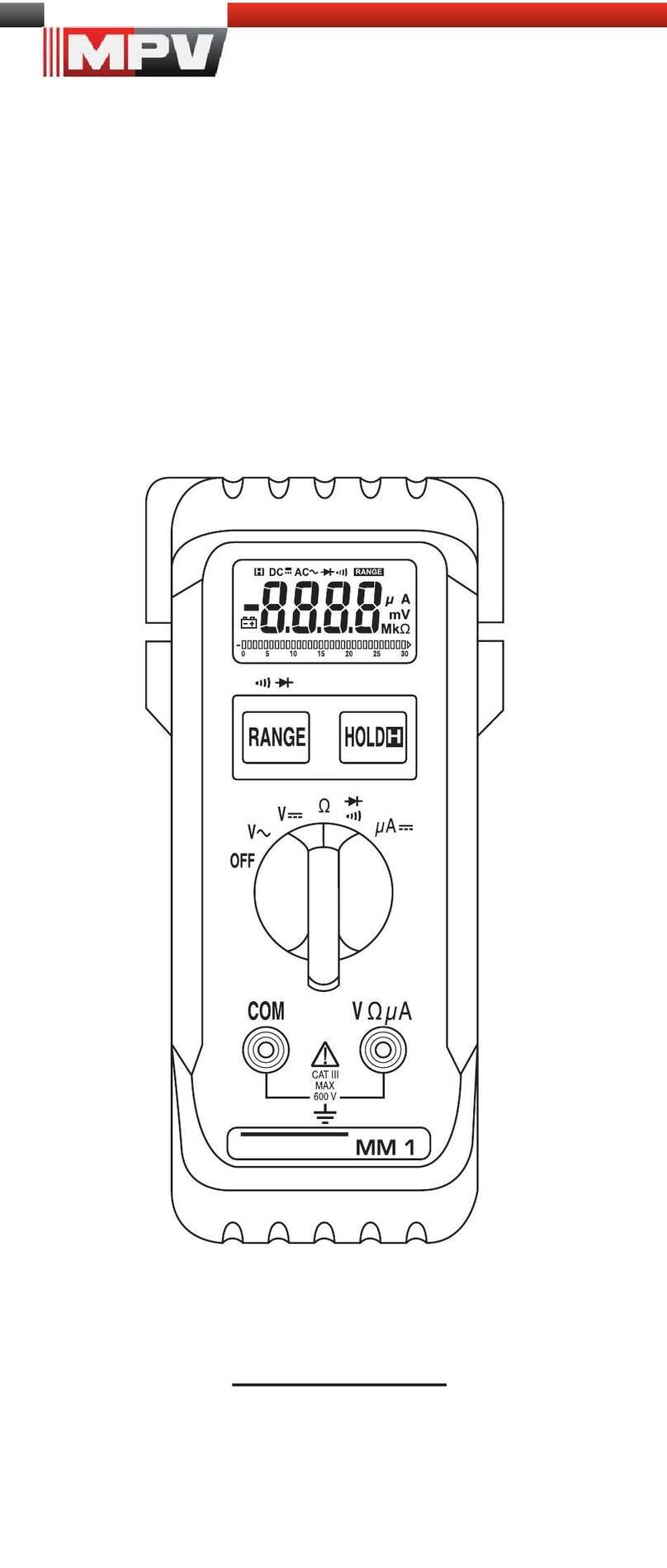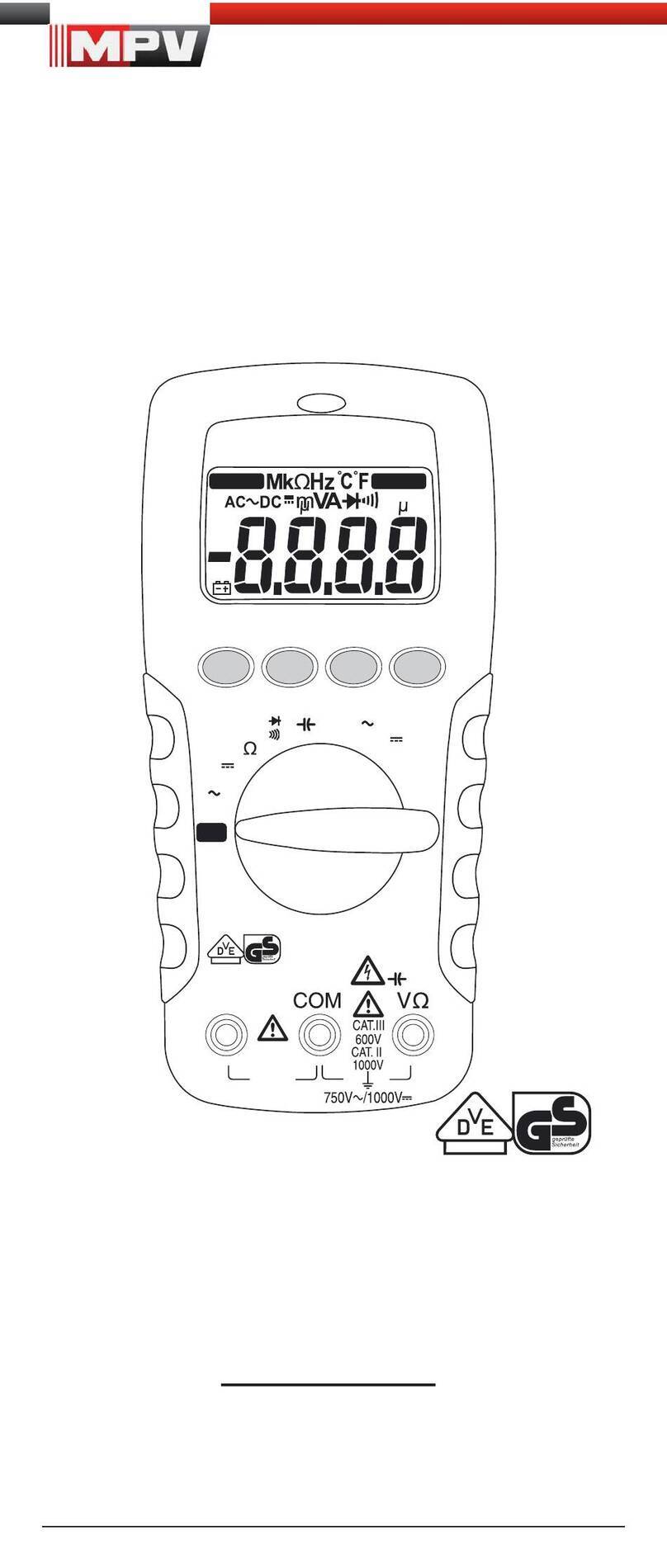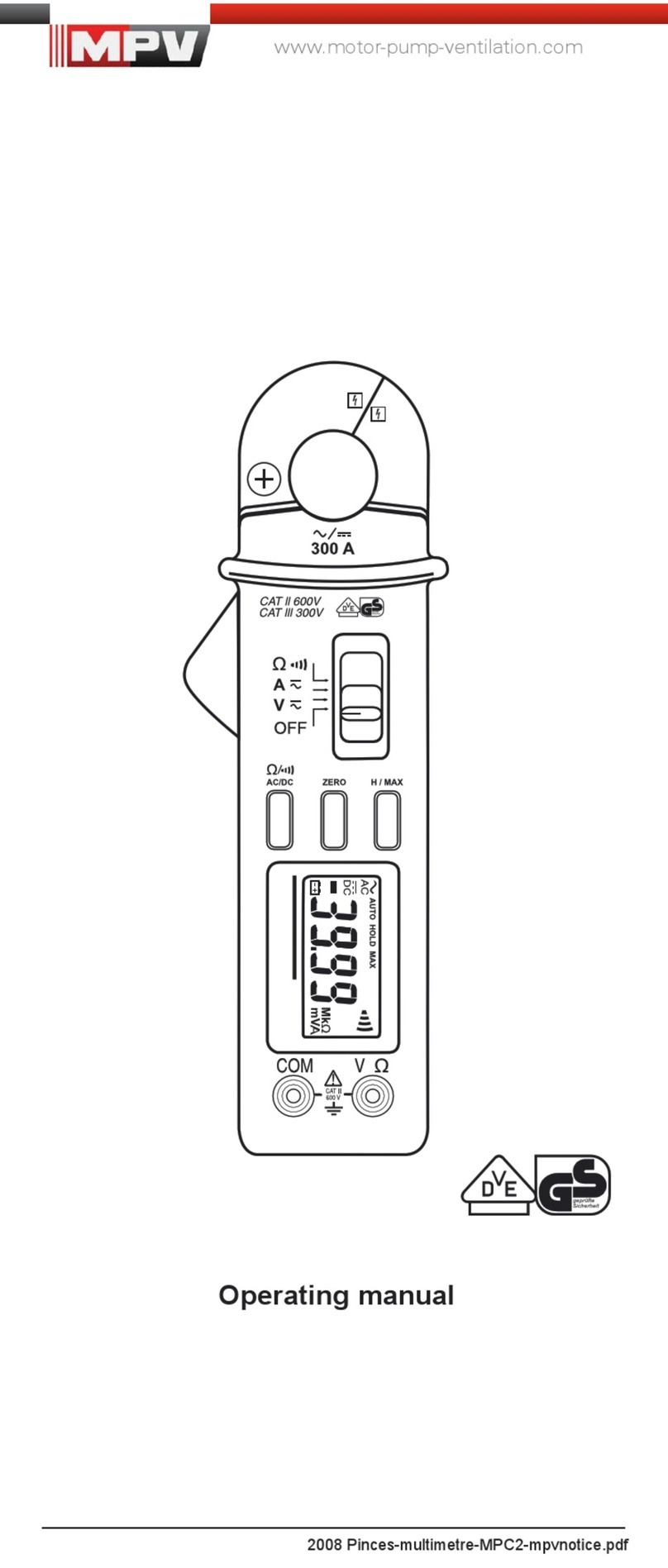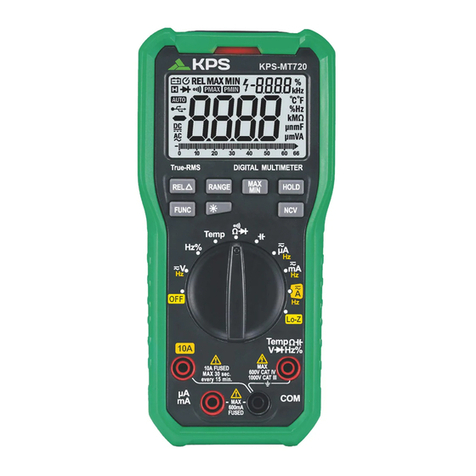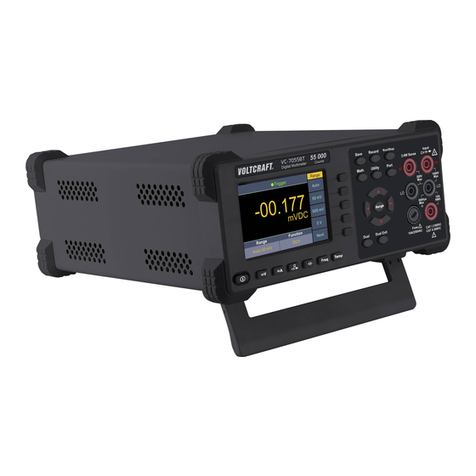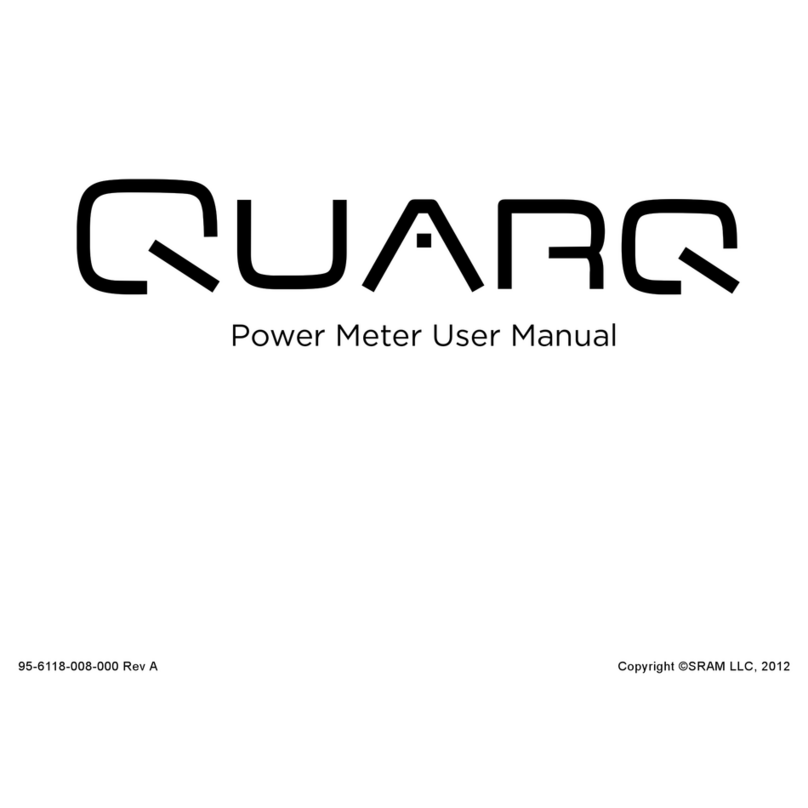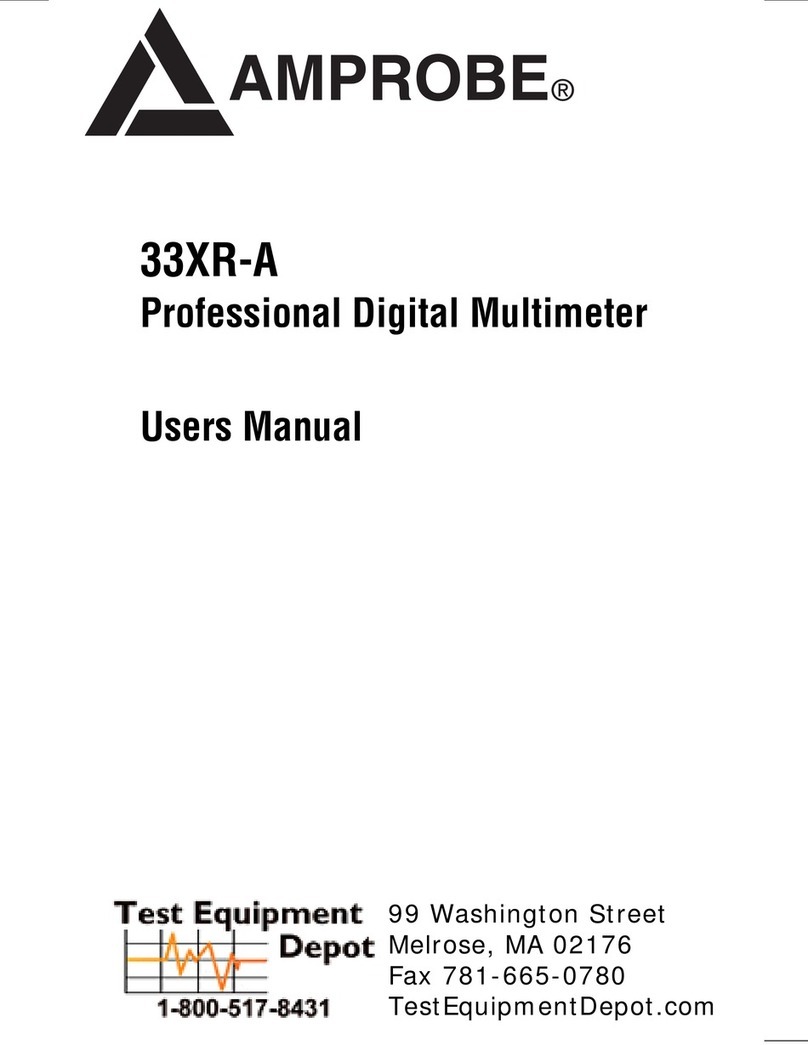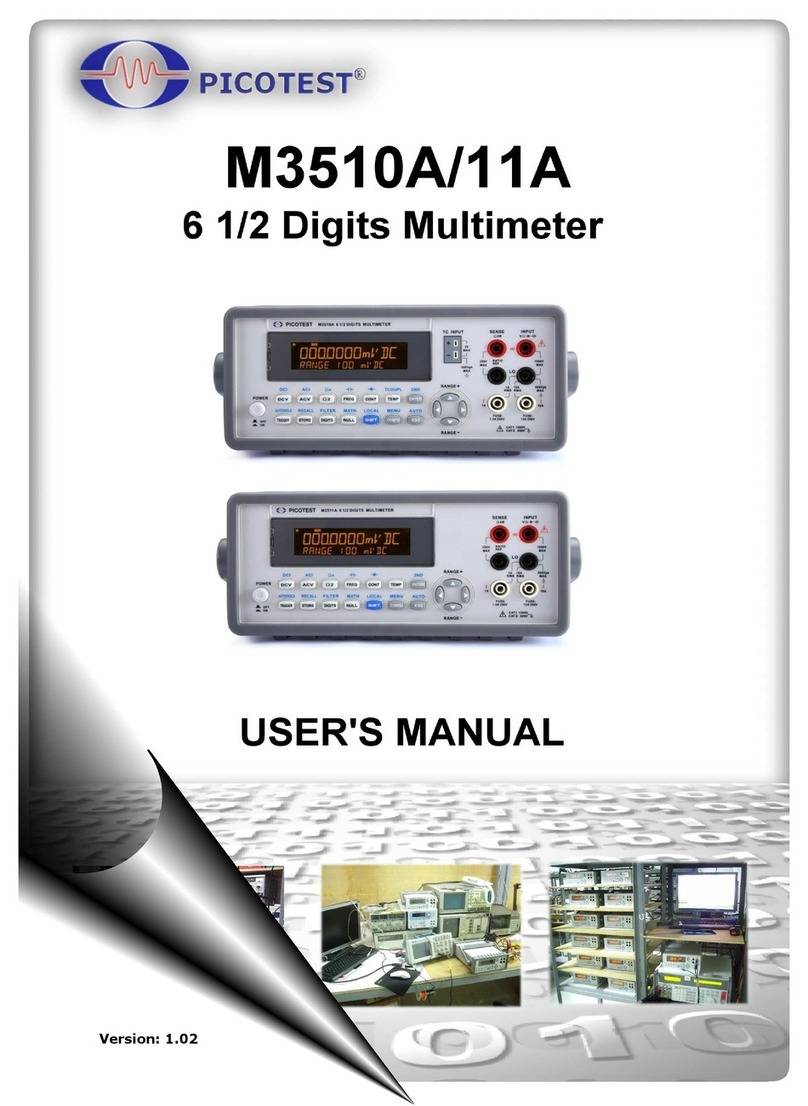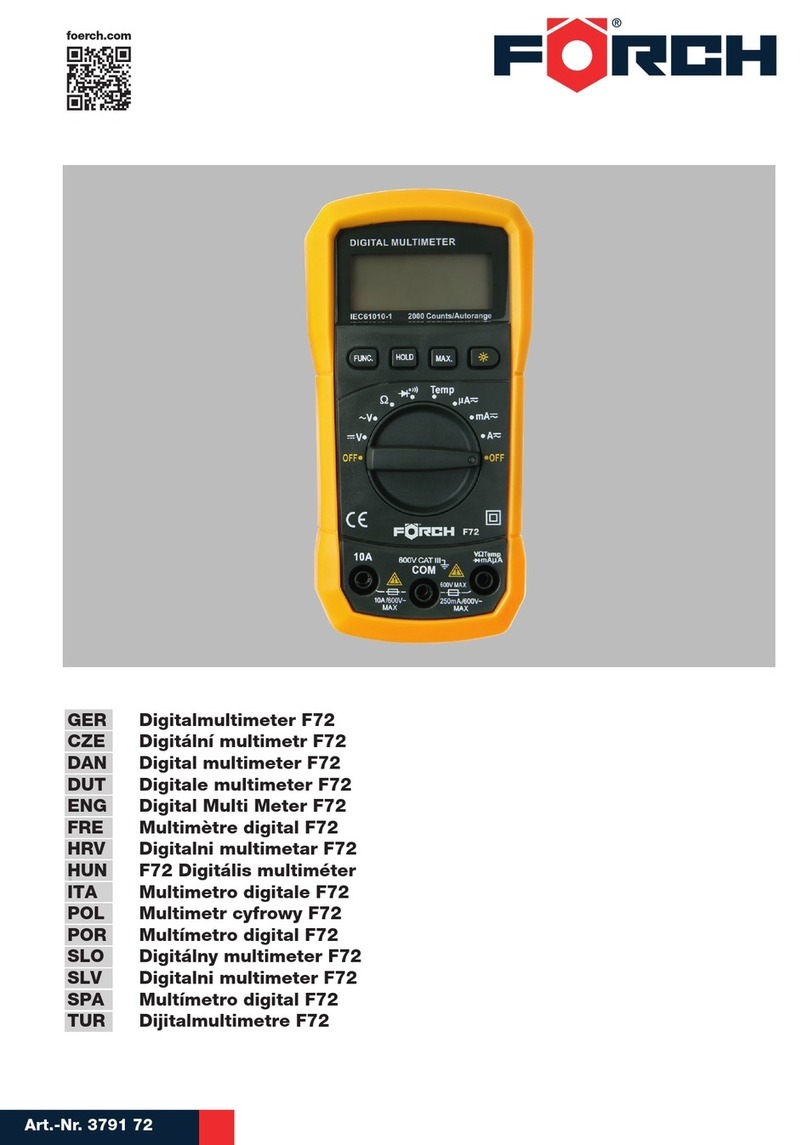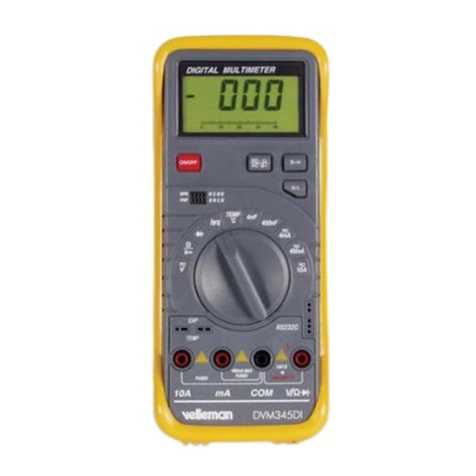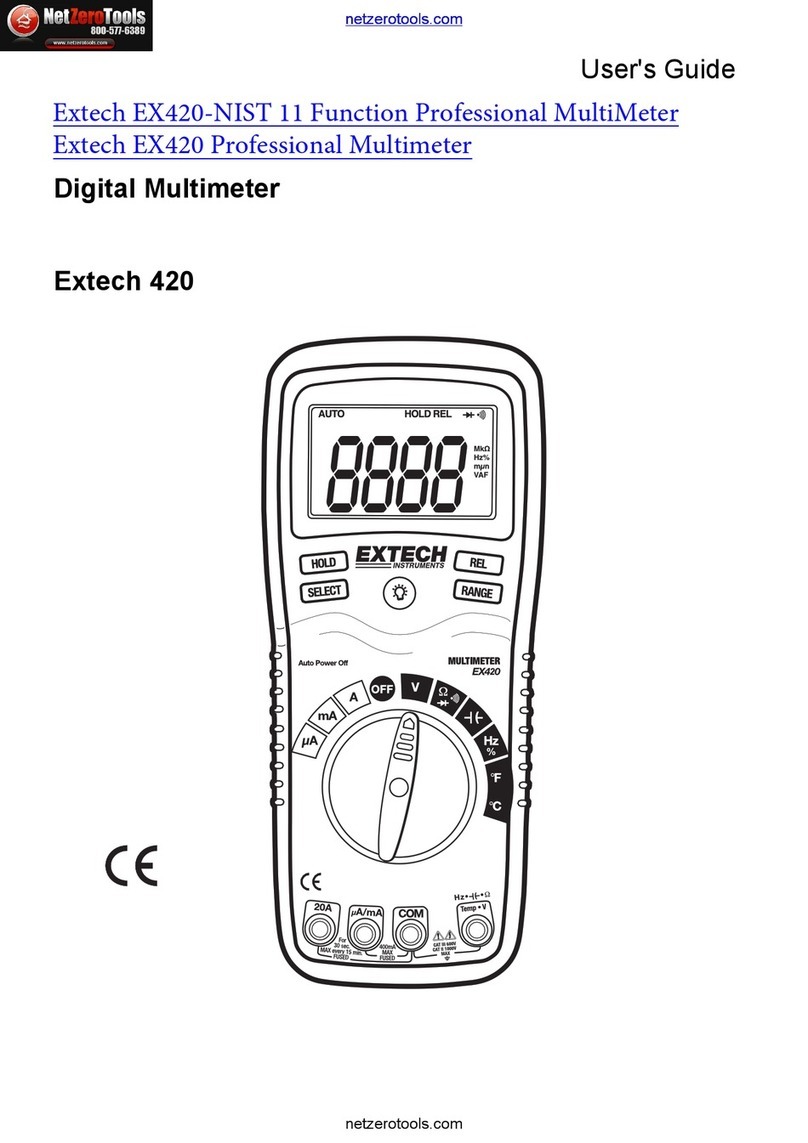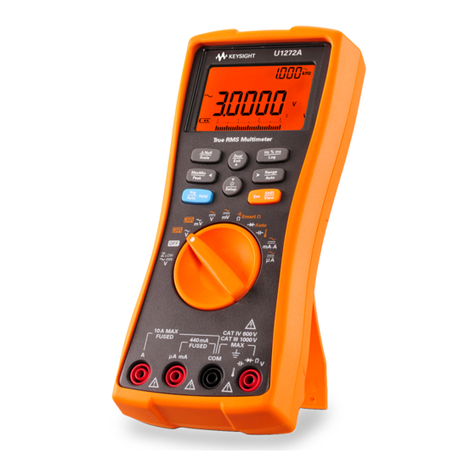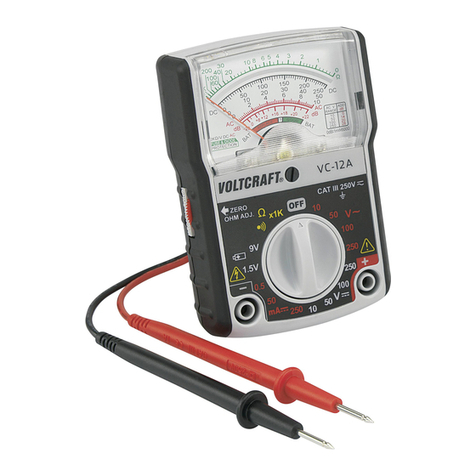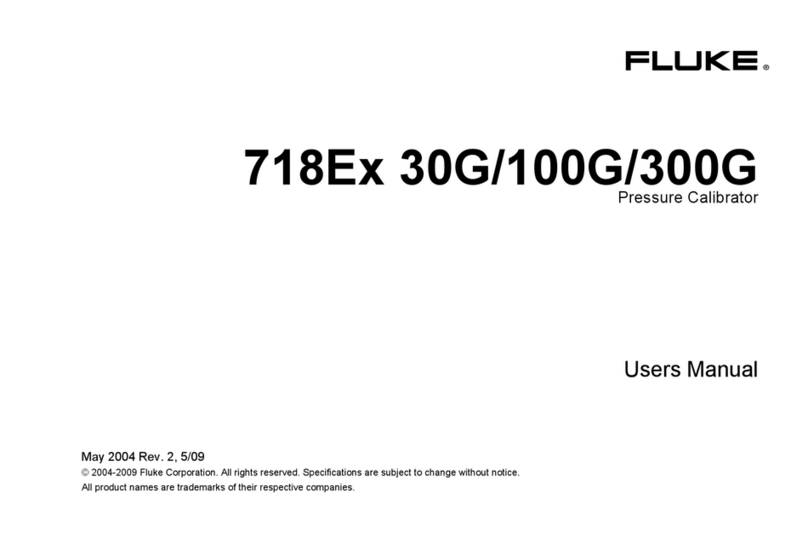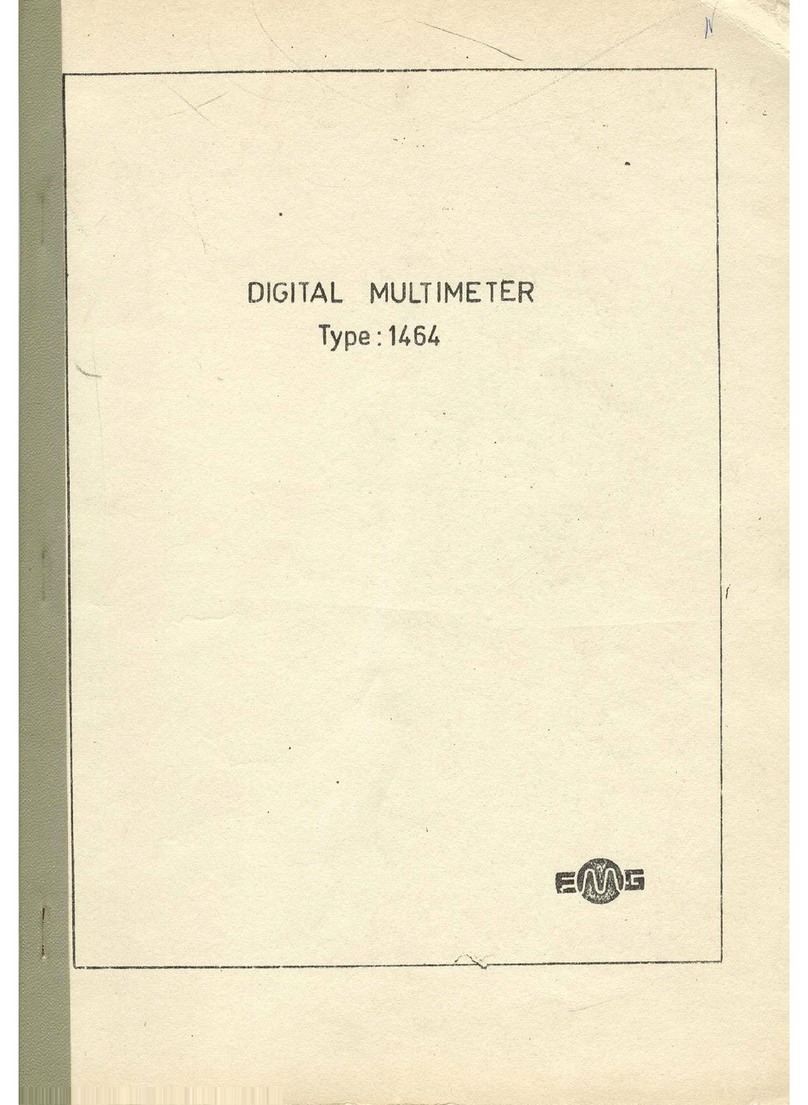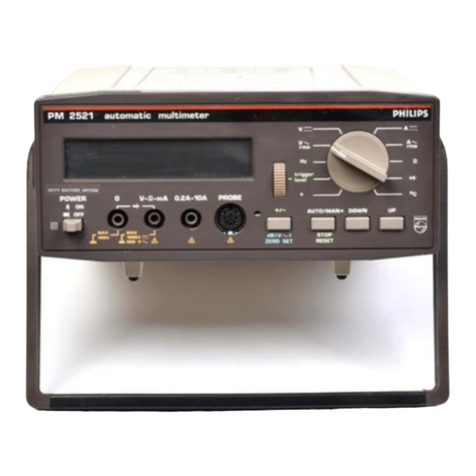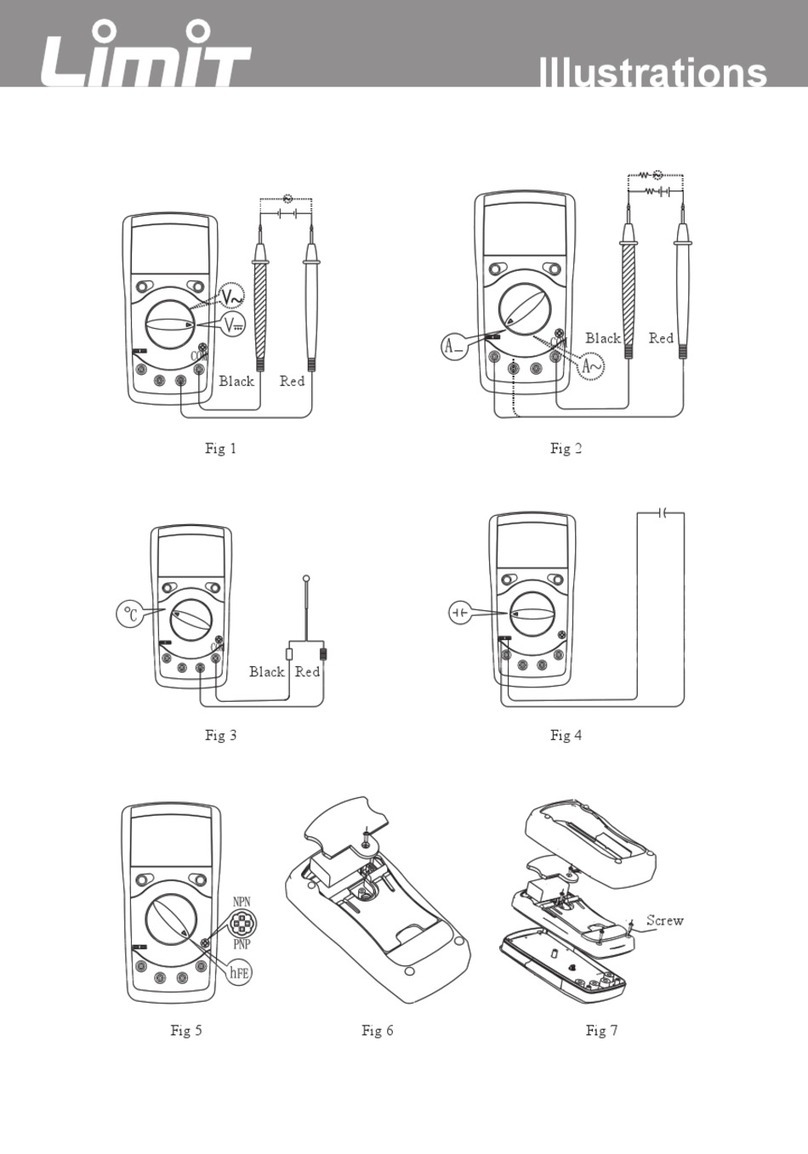MPV MN 3 User manual

0XOWLPHWUH01PSYQRWLFHSGI
8VHUVPDQXDO
M13
www.motor-pump-ventilation.com

Bild 1: Gerätefrontseite
Fig. 1: Front tester panel
Fig. 1: Panneau avant de l‘appareil
Fig. 1: Parte frontal del equipo
Obr.1: Přední strana přístroje
ill. 1: Lato anteriore apparecchio
Fig. 1: Voorzijde van het apparaat
Rys.1: Panel przedni przyrządu
Imaginea 1: Partea frontală a aparatului
Рис. 1. Фронтальная сторона прибора
Fig. 1: Framsida
Res. 1: Cihaz ön yüzü
0XOWLPHWUH01PSYQRWLFHSGI
www.motor-pump-ventilation.com

Bild 2: Gleichspannungsmessung
Fig. 2: Direct voltage measurement
Fig. 2: Mesure de tension continue
Fig. 2: Medición de tension contínua
Obr.2: Měření stejnosměrného napětí
ill. 2: Misura tensione continua
Fig. 2: Meten van gelijkspanning
Rys.2: Pomiar napięcia stałego
Imaginea 2: Măsurarea tensiunii continue
Рис. 2. Измерение напряжения постоянного тока
Fig. 2: Likspänningsmätning
Res.2: Doğru Gerilim Ölçümü
Bild 3: Wechselspannungsmessung
Fig. 3: Alternating voltage measurement
Fig. 3: Mesure de tension alternative
Fig. 3: Medición de tensión alterna
Obr.3: Měření střídavého napětí
ill. 3: Misura tensione alternata
Fig. 3: Meten van wisselspanning
Rys.3: Pomiar napięcia przemiennego
Imaginea 3: Măsurarea tensiunii alternative
Рис. 3. Измерение напряжения переменного тока
Fig. 3: Växelspänningsmätning
Res.3: Alternatif Gerilim Ölçümü
Bild 4: Gleichstrommessung
Fig. 4: DC current measurement
Fig. 4: Mesure de courant continu
Fig. 4: Medición de corriente contínua
Obr.4: Měření stejnosměrného proudu
ill. 4: Misura corrente continua
Fig. 4: Meten van gelijkstroom
Rys.4: Pomiar prądu stałego
Imaginea 4: Măsurarea curentului continuu
Рис. 4. Измерение постоянного тока
Fig. 4: Likströmsmätning
Res.4: Doğru Akım Ölçümü
0XOWLPHWUH01PSYQRWLFHSGI
www.motor-pump-ventilation.com

Bild 6: Widerstandsmessung
Fig. 6: Resistance measurement
Fig. 6: Mesure de résistance
Fig. 6: Medición de resistencia
Obr.6: Měření odporu
ill. 6: Misura di resistenza
Fig. 6: Weerstandsmeting
Rys.6: Pomiar rezystancji
Imaginea 6: Măsurarea rezistenţei
Рис. 6. Измерение сопротивления
Fig. 6: Resistansmätning
Res.6: Direnç Ölçümü
Bild 7: Diodenprüfung
Fig. 7: Diode Testing
Fig. 7: Contrôle de diodes
Fig. 7: Verificación de diodos
Obr.7: Měření diod
ill. 7: Prova diodi
Fig. 7: Diodecontrole
Rys.7: Pomiar diody
Imaginea 7: Măsurarea diodelor
Рис. 7. Проверка диодов
Fig. 7: Diod-test
Res.7: Diyot kontrolü
Bild 5: Wechselstrommessung
Fig. 5: AC current measurement
Fig. 5: Mesure de courant alternatif
Fig. 5: Medición de corriente alterna
Obr. 5: Měření střídavého proudu
ill. 5:
Misura corrente alternata
Fig. 5: Meten van wisselstroom
Rys.5: Pomiar prądu przemiennego
Imaginea 5: Măsurarea curentului alternative
Рис. 5. Измерение переменного тока
Fig. 5: Växelströmsmätning
Res.5: Alternatif Akım Ölçümü
0XOWLPHWUH01PSYQRWLFHSGI
www.motor-pump-ventilation.com

Bild 9: Kapazitätsmessung
Fig. 9: Capacity Testing
Fig. 9: Mesure de capacité
Fig. 9: Medición de capacidad
Obr. 9: Měření kapacity
ill. 9: Misura di capacità
Fig. 9: Capaciteitsmeting
Rys.9: Pomiar pojemności
Imaginea 9: Măsurarea capacităţii
Рис. 9. Измерение емкости
Fig. 9: Kapacitansmätning
Res.9. Kapasite Ölçümü
Bild 8: Durchgangsprüfung mit Summer
Fig. 8: Continuity Testing with buzzer
Fig. 8: Contrôle de continuité avec ronfleur
Fig. 8: Control de continuidad con vibrador
Obr.8: Zkouška průchodu bzučákem
ill. 8: Prova di continuità con cicalino
Fig. 8: Doorgangstest met akoestisch signaal
Rys.8: Pomiar ciągłości obwodu
Imaginea 8: Măsurarea continuităţii cu buzzer
Рис. 8. Контроль прохождения тока с зуммером
Fig. 8: Genomgångstest med summer
Res.8: Sesli Uyarıcı ile Süreklilik kontrolü
Bild 10: Frequenzmessung
Fig. 10: Frequency measurement
Fig. 10: Mesure de fréquence
Fig. 10: Medición de frecuencia
Obr. 10: Měření kmitočtu
ill. 10: Misura di capacità
Fig. 10: Frequentiemeting
Rys.10: Pomiar częstotliwości
Imaginea 10:
Măsurarea frecvenţei
Рис. 10. Измерение частоты
Fig. 10: Frekvensmätning
Res.10: Frekans Ölçümü
0XOWLPHWUH01PSYQRWLFHSGI
www.motor-pump-ventilation.com

Bild 12: Sicherungswechsel
Fig. 12: Fuse replacement
Fig. 12: Remplacement des fusibles
Fig. 12: Cambio de fusible
Obr. 12: Výměna pojistek
ill. 12: Sostituzione fusibile
Fig. 12: Vervanging van de smeltzekeringen
Rys.12: Wymiana bezpiecznika
Imaginea 12:
Înlocuirea siguranţelor
Рис. 12. Замена предохранителя
Fig. 12: Säkringsbyte
Res.12: Sigorta Değişimi
Bild 11: Batteriewechsel
Fig. 11: Battery replacement
Fig. 11: Cambio de pila
Fig. 11: Remplacement de la pile
Obr. 11: Výměna baterií
ill. 11: Sostituzione batterie
Fig. 11: Vervanging van de batterijen
Rys.11: Wymiana baterii
Imaginea 11:
Schimbarea bateriei
Рис. 11. Замена батарейки
Fig. 11: Batteribyte
Res.11: Batarya Değişimi
0XOWLPHWUH01PSYQRWLFHSGI
www.motor-pump-ventilation.com

Bild 13: Aufwicklung der Sicherheitsmessleitung
Fig. 13: Wrapping up the safety test leads
Fig. 13: Enroulement du câble de mesure de sécurité
Fig. 13: Arrollamiento de la conducción protegida de medición
Obr.13: Navinutí měřících vodičů
ill. 13: Avvolgimento dei cavetti di sicurezza
Fig. 13: Wikkeling van veiligheidsmeetsnoeren
Rys.13: Zwijanie przewodów pomiarowych
Imaginea 13:
Înfăşurarea firelor de măsurare pe rama din cauciuc
Рис. 13. Намотка безопасного измерительного провода
Fig. 13: Placering av säkerhetsmätsladdar
Res.13: Emniyet Ölçüm Tesisatının Sarılması
0XOWLPHWUH01PSYQRWLFHSGI
Bild 14: Aufstellung des 01
Fig. 14: Standing up the 01
Fig. 14: Installation du 01
Fig. 14: Colocación del 01
Obr.14: Postavení přístroje 01
ill. 14: Posizionamento del 01
Fig. 14: Opstelling van de multimeter
Rys.14: Przyrząd 01 w pozycji stojącej
Imaginea 14:
Poziţionarea pe verticală a aparatului 01
Рис. 14. Установка прибора 01
Fig. 14: Instrumentstöd 01
Res.14: 01 3’ün kurulumu
www.motor-pump-ventilation.com

Operating Manual
M13
Digital Multimeter for
- DC voltage measurement
- AC voltage measurement
- DC current measurement
- AC current measurement
- Resistance measurement
- Diode testing
- Continuity testing
- Capacitance measurement
- Frequency measurement
Index of Contents
1. Operating instructions
2. Safety instructions
3. Contents of delivery
4. Meter description
5. General Specifications
6. Environmental Conditions
7. Electrical Specifications
8. Measuring with MN3
9. Maintenance
10. How to use the protective rubber holster
11. Technical data of the measuring accessories
12. Environmental notice
1. Operating Instructions
This operating manual is intended for
- electrical professionals
- qualified electrotechnical persons
The MN3 is designed for measuring in dry conditions. It must not be
used on electrical circuits with a rated voltage greater than 600 V AC/DC (for
details refer to "Environmental Conditions" section).
The following symbols appear in this manual and on the MN3 :
This symbol indicates dangerous voltage.
This symbol indicates warnings and cautions to be observed when
using the MN3 (refer to manual!)
This symbol on the MN3 indicates that the MN3
has double insulation (Protection Class II)
This symbol on the MN3 indicates the unit contains
built-in fuses.
This symbol appears in the display when the battery is low.
This symbol indicates the "Continuity testing" mode is selected.
The buzzer sounds for acoustic test results.
This symbol indicates the "Diode testing" mode is selected.
(DC) Direct voltage or current.
(AC) Alternating voltage or current.
Ground (voltage against earth)
Capacitor (terminals)
0XOWLPHWUH01PSYQRWLFHSGI
www.motor-pump-ventilation.com

2. Safety instructions
Below is an example of a safety instruction:
Dangerous voltage!
Follow the safety instruction!
Before using the 01, please read the operating manual carefully.
Follow the safety instructions in this manual. In this way you will ensure safe
operation and will retain the 01 in safe condition.
3. Contents of delivery
The following items are included in the delivery of a M13:
3.1 one 01
3.2 one safety test lead, red (L= 1.4 m ; Probe diam. = 4 mm) with protec-
tive cap
3.3 one safety test lead, black (L= 1.4 m; Probe diam. = 4 mm) with protec-
tive cap
3.4 one protective rubber holster
3.5 one compact protective carrying case
3.6 one 9 V battery and two different fuses (built into unit)
3.7 one operating manual
Note on replaceable parts :
- The 01 contains fuses for overload protection :
One fast blow fuse rated 16 A (500 V), D = 6.35 mm , L = 32 mm (P.no.
749770) and one fast blow fuse rated 1 A (500 V), D = 6.35 mm, L = 32 mm
(P.no. 749669).
- The 01 is powered by a built-in 9 V block battery (IEC 6 LR 61).
4. Tester description
refer to figure 1 front tester panel
The display and operating elements shown in figure 1 are denoted as follows:
Digital display for measurement values, display for overrange indication,
Polarity display,
Battery indicator, appears when the battery is low,
Selector switch for direct voltage (DC) or alternating voltage (AC),
Rotary switch for function and range selection
Terminals for capacitance measurements
Input terminal (positive1) for V, W and Hz,
COM-Terminal, common return terminal for current, voltage, resistance
and frequency measurements, continuity and diode tests,
Input terminal (positive) for mA/mA range, for currents up to 200 mA,
Input terminal (positve) for 20 A range, for currents up to 20 A,
Protective rubber holster
1) the automatic polarity display for direct and alternating current refers to this terminal
5. General Specifications
5.1 General specifications for the 01
5.1.1 The digital display is a 3½ digit liquid crystal display with 20 mm digit
height and automatic decimal point placement. The highest display
value is 1999.
5.1.2 The polarity display is automatic. As positive is implied by the
defined input terminal, only a negative pole will be indicated with "-".
5.1.3 Overranging is indicated by "1" or "-1".
5.1.4 The measuring rate of the 01 is a nominal 2,5 readings
per second rate.
5.1.5 The 01 is turned on and off using the rotary switch .
Unit is turned off when switch is in "OFF" position.
5.1.6 The 01 powers off automatically after approx. 30 minutes.
It can be powered on again by turning the rotary switch to select
another range.
5.1.7 Temperature coefficient of the measurement reading: 0.15 x (given
accuracy)/ °C , < 18 °C or > 28 °C.
5.1.8 The 01 is powered by a 9 V block battery (IEC 6 LR 61).
5.1.9 When the battery voltage drops below the operating voltage of the
01 a low battery symbol appears in the display.
5.1.10 The lifespan of a battery is approx. 150 hours (Alkaline battery).
5.1.11 Meter dimensions :
(L x W x H) = 175 x 84 x 31 mm without protective rubber holster
(L x W x H) = 192 x 95 x 50 mm with protective rubber holster
Meter weight:
340 g without protective rubber holster
0XOWLPHWUH01PSYQRWLFHSGI
www.motor-pump-ventilation.com

550 g with protective rubber holster
5.1.12 The safety test leads feature 4 mm diameter needle pointed tips. The
safety test leads provided with the meter are specifically suited for the
rated voltage and current of the 01. The probe tips can
be covered with protective caps.
5.1.13 The 01 is protected from mechanical damage by a pro-
tective rubber holster . The protective rubber holster allows the
01 to be placed upright or hung up during measuring.
6. Environmental conditions
- The 01is designed for measuring in dry conditions,
- Altitude during measuring: 2000 m maximum
- Overvoltage category/ Location category: IEC 664/ IEC 1010-1:1990 →
600 V Category II; 300 V Category III,
- Pollution degree : 2,
- Protection Class: IP 30 (DIN VDE 0470-1 IEC/ EN 60529)
IP 30 means: Protection against access to dangerous parts and protection
against solid impurities of a diameter > 2.5 mm, (3 - first index). No protec-
tion against water, (0 - second index).
- Working temperature and relative humidity:
for working temperature between 0 °C and 30 °C : relative humidity smaller
than 80 %
for working temperature between 30 °C and 40 °C : relative humidity smaller
than 75 %
for working temperature between 40 °C and 50 °C : relative humidity smaller
than 45 %
- Storage temperature: the 01 can be stored at temperatures
between - 20 °C and + 60 °C. The battery should be removed when tester
is in storage.
7. Electrical specifications
Note: measurement accuracy is given as the sum of
- a relative percentage of the reading and
- the number of least significant digits
This accuracy is valid for temperatures between 18 °C and 28 °C, with a relative
humidity smaller than 75 %.
7.1 Direct voltage ranges
The input impedance is 10 MΩ.
Range
Resolution Accuracy
Overload protection
200 mV 100 µV ± (0,5 % of reading + 2 digits) 600 Vrms
2 V 1 mV ± (0,5 % of reading + 2 digits) 600 Vrms
20 V 10 mV ± (0,5 % of reading + 2 digits) 600 Vrms
200 V 100 mV ± (0,5 % of reading + 2 digits) 600 Vrms
600 V 1 V ± (0,5 % of reading + 2 digits) 600 Vrms
7.2 Alternating voltage ranges
The input impedance is 10 MΩ parallel 100 pF. The measurement value is
arrived at by average sensing and is displayed as the RMS value.
Range
Resolution
Accuracy in 40 Hz - 500 Hz
frequency range Overload protection
200 mV 100 µV ± (1,3 % of reading + 5 digits) 600 Vrms
2 V 1 mV ± (1,3 % of reading + 5 digits) 600 Vrms
20 V 10 mV ± (1,3 % of reading + 5 digits) 600 Vrms
200 V 100 mV ± (1,3 % of reading + 5 digits) 600 Vrms
600 V 1 V ± (1,3 % of reading + 5 digits) 600 Vrms
7.3 Direct current ranges
Overload protection:
- 1 A (500 V) fast blow fuse on µA/ mA input terminal
- 16 A (500 V) fast blow fuse on 20 A input terminal
Current measurements in the 20 A range must last for 30 seconds maximum
followed by a 3 minute break, 10 A continous.
0XOWLPHWUH01PSYQRWLFHSGI
www.motor-pump-ventilation.com

Range
Resolution Accuracy Burden Voltage
200 µA 0,1 µA ± (1,0 % of reading + 2 digits) 600 mV max.
2 mA 1 µA ± (1,0 % of reading + 2 digits) 600 mV max.
20 mA 10 µA ± (1,0 % of reading + 2 digits) 600 mV max.
200 mA 100 µA ± (1,0 % of reading + 2 digits) 900 mV max.
20 A 10 mA ± (2,0 % of reading + 3 digits) 900 mV max.
7.4 Alternating current ranges
The measurement value is arrived at by average sensing and is displayed as
the RMS value.
Overload protection:
- 1 A (500 V) fast blow fuse on µA/ mA input terminal
- 16 A (500 V) fast blow fuse on 20 A input terminal
Current measurements in the 20 A range must last for 30 seconds maximum
followed by a 3 minute break, 10 A continous.
Range
Resolution
Accuracy in 40 Hz - 500 Hz
frequency range Burden Voltage
200 µA 0,1 µA ± (1,5 % of reading + 3 digits) 600 mVrms max.
2 mA 1 µA ± (1,5 % of reading + 3 digits) 600 mVrms max.
20 mA 10 µA ± (1,5 % of reading + 3 digits) 600 mVrms max.
200 mA 100 µA ± (1,5 % of reading + 3 digits) 900 mVrms max.
20 A 10 mA ± (2,5 % of reading + 5 digits) 900 mVrms max.
7.5 Resistance ranges
Overload protection for resistance measurements: 600 Vrms.
Range
Resolution
Accuracy
Maximum
test current
Max. open
circuit voltage
200 Ω 0,1 Ω ± (0.8 % of reading + 4 digits) 2,5 mA 3,2 V
2 kΩ 1 Ω ± (0.8 % of reading + 2 digits) 200 µA 0,5 V
20 kΩ 10 Ω ± (0.8 % of reading + 2 digits) 40 µA 0,5 V
200 kΩ 100 Ω ± (0.8 % of reading + 2 digits) 4 µA 0,5 V
2 MΩ 1 kΩ ± (0.8 % of reading + 2 digits) 400 nA 0,5 V
20 MΩ 10 kΩ ± (2 % of reading + 5 digits) 40 nA 0,5 V
7.6 Diode and Continuity Testing
The accuracy indicated below is valid in the range of 0.4 V to 0.9 V.
Overload protection for diode testing: 600 Vrms.
The built-in buzzer sounds if the resistance R falls below 50 Ω.
Range
Resolution
Accuracy
Maximum
test current
Max. open
circuit voltage
1 mV ± (1,5 % of reading + 5 digits) 1,5 mA 3,2 V
7.7 Capacitance ranges
Conditions: Capacitors must be discharged before testing and then connected
to the meter according to the indicated polarity.
Range
Resolution
Accuracy
Frequency
2 nF 1 pF ± (2,0 % of reading + 4 digits) 40 Hz
20 nF 10 pF ± (2,0 % of reading + 4 digits) 40 Hz
200 nF 100 pF ± (2,0 % of reading + 4 digits) 40 Hz
2 µF 1 nF ± (2,0 % of reading + 4 digits) 40 Hz
0XOWLPHWUH01PSYQRWLFHSGI
www.motor-pump-ventilation.com

20 µF 10 nF ± (2,0 % of reading + 4 digits) 40 Hz
200 µF 100 nF ± (2,0 % of reading + 4 digits) 40 Hz
7.8 Frequency ranges
The frequency to be measured must have a minimum input signal of
200 mVrms.
Range Resolution
Accuracy
for 5 Vrms max. Minimum input
frequency
Overload
protection
2 kHz 1 Hz ± (1,0 % of reading + 3 digits) 20 Hz 600 Vrms
20 kHz 10 Hz ± (1,0 % of reading + 3 digits) 200 Hz 600 Vrms
200 kHz 100 Hz ± (1,0 % of reading + 3 digits) 2 kHz 600 Vrms
8. Measuring with 01
8.1 Measurement preparation
The MN3 3 must be used and stored only at the indicated storage and
working temperatures, avoid exposure to continuous sunlight.
- Check the rated voltage and current indications on the test leads. The
safety test leads provided with the 01 correspond specifically
to the rated voltage and current of the 01.
- Inspect the test leads for damaged insulation. If the insulation is damaged,
the test leads should be discarded immediately.
- Check test lead continuity. If the conductor in the test lead is damaged, the
leads should be discarded immediately.
- Remove test leads from circuit to be measured before turning the rotary
switch to select another function.
- If the 01 is used near strong noise generating sources, the
display may become unstable and measurement errors may arise.
8.2 Voltage and current measurement
To avoid electrical shock, observe the maximum rated voltage
to earth ground!
The maximum rated voltage that should be applied between any of the following
terminals of the 01 and earth ground is 600 V.
- COM terminal
- Input terminal for V, Ω, and Hz
- Input terminal for µA/ mA range
- Input terminal for 20 A range
Electrical hazard! Maximum permissible circuit voltage for
current measurement is 500 V! If a safety fuse blows at a
voltage above 500 V the 01 could be damaged.
A damaged tester presents an electrical shock hazard to the
user!
8.2.1 Voltage measurement
- Select the appropriate range with the rotary switch of the
01.
- Use the selector switch of the 01 to select the required
direct (DC) or alternating (AC) voltage to be measured.
- Connect the black safety test lead to the COM-terminal of the
01.
- Connect the red safety test lead to the input terminal for V, Ω, and Hz of
the 01.
- Connect the safety test leads to the circuit measurement points and read
the measured value on the digital display of the 01.
see Figure 2: Direct voltage measurement
see Figure 3: Alternating voltage measurement
8.2.2 Current measurement
- Select the appropriate range with the rotary switch of the
01.
- Use the selector switch of the 01 to select the required
direct (DC) or alternating (AC) current to be measured.
- Connect the black safety test lead to the COM-terminal of the
01
0XOWLPHWUH01PSYQRWLFHSGI
www.motor-pump-ventilation.com

- Connect the red safety test lead to the input terminal for the µA/ mA range
for currents up to 200 mA, or to the input terminal for the 20 A range
for currents between 200 mA and 20 A of the MN3 .
- Connect the safety test leads to the circuit measurement points and read
the measured value on the digital display of the MN3 .
see Figure 4: DC current measurement
see Figure 5: AC current measurement
8.3 Resistance Measurement
- Select the appropriate range with the rotary switch of the
01.
- Connect the black safety test lead to the COM-terminal of the
01.
- Connect the red safety test lead to the input terminal for V, Ω, and Hz of
the 01.
- Connect the safety test leads to the circuit measurement points and read
the measured value on the digital display of the 01.
see Figure 6: Resistance measurement
8.4 Diode Testing
- Turn the rotary switch of the 01to select the appropriate
range identified by a buzzer and diode symbol ( , ).
- Connect the black safety test lead to the COM-terminal of the
01.
- Connect the red safety test lead to the input terminal for V, Ω, and Hz of
the 01.
- Connect the safety test leads across the diodes and read the measured
value on the digital display of the 01.
- For a typical silicone diode tested in the forward-biased direction a voltage
flow between 0,500 V and 0,900 V is displayed. A display showing "000"
indicates a short circuit in the diode, whereas a display showing "1" indi-
cates an open circuit in the diode.
- For a diode tested in the reverse-biased direction the display reads "1". If
the diode is damaged, the display will show "000" or other values.
see Figure 7: Diode Testing
8.5 Continuity Testing with Buzzer
- Turn the rotary switch of the 01 to select the appropriate
range identified by a buzzer and diode symbol ( , ).
- Connect the black safety test lead to the COM-terminal of the
01.
- Connect the red safety test lead to the input terminal for V, Ω, and Hz of
the 01.
- Connect the safety test leads to the circuit to be measured. If the circuit
resistance between the COM-terminal and the input terminal for V, Ω and
Hz falls below 50 Ω, then the built-in buzzer in the 01 emits
a continuous tone.
see Figure 8: Continuity Testing with buzzer
8.6 Capacitance Measurement
CAUTION! Capacitors must be completely discharged before
attempting capacitance measurement! Never apply voltage
to the input terminals for a capacitance measurement as this
could destroy or damage the tester! A damaged tester may
present an electrical shock hazard to the user!
- Use the rotary switch to select the appropriate range on the
01.
- Establish the polarity of the capacitor and discharge the capacitor com-
pletely.
- Connect the fully discharged capacitor according to its polarity to the input
terminals for capacitance measurement of the 01 and read
the measurement value on the digital display of the 01.
see Figure 9: Capacity Testing
8.7 Frequency measurement
- Use the rotary switch to select the appropriate range on the
01.
- Connect the black safety test lead to the COM-terminal of the
01.
- Connect the red safety test lead to the input terminal for V, Ω, and Hz of
the 01. Observe the voltage range of the 01 for
frequency measurements!
www.motor-pump-ventilation.com

- Connect the safety test leads to the circuit measurement points and read
the measured value on the digital display of the 01
see Figure 10: Frequency measurement
9. Maintenance
Remove test leads and turn the power off before opening the
01! Dangerous voltage!
Any work to be carried out on an opened 01 under voltage is
strictly reserved for qualified electrotechnical personnel who must take special
precautionary measures to avoid accidents.
This is how to ensure that the 01 is free from any voltage before
the instrument is opened:
- first remove the safety test leads from measured object.
- then remove both safety test leads from the 01.
- turn the rotary switch to the "OFF" position.
9.1 Instrument safe-guarding
In certain circumstances, safety during the use of the 01 can no
longer be guaranteed; when for instance:
- there is visible damage to the housing
- measurement errors occur
- the instrument has been subjected to prolonged storage under unfavorable
conditions and
- the instrument has been subjected to severe transport stresses.
In such cases the 01must be immediately switched off, removed
from the measurement points and secured against any future unintentional
operation.
9.2 Cleaning
Wipe the case of the 01 with a clean dry cloth (exception: spe-
cial cleaning cloths). Do not use any solvents and/or abrasives to clean the
01.
9.3 Battery replacement
Remove test leads and turn the power off before opening the
01! Dangerous voltage!
The 01 is powered by a 9 V block battery. Battery replacement
(see figure 11 below) becomes necessary when the low battery indicator shows
in the display .
This is how to change the battery:
- Remove the safety test leads from the measured circuit.
- Remove the safety test leads from the 01.
- Turn the rotary switch to the "OFF" position.
- Remove the protective rubber holster from the 01.
- Place the01 on its front side and remove the three screws
from the case back.
- Lift the end of the case back near the input terminals until it gently unsnaps
from the case front at the end nearest to the LCD display .
- Remove the empty battery from inside the case front and carefully discon-
nect it from the battery connector leads.
- Snap the battery connector leads to the terminals of a new battery and
reinsert the battery into the case front. Ensure that the battery leads do not
become pinched between the case back and case front.
- Press the case back and case front together again and reinstall the three
screws.
- Place the 01 back into its protective rubber holster .
see Figure 11: Battery replacement
Please contribute to environmental protection! Batteries should
not be thrown into domestic refuse bins! They can be discarded
at collection points for old batteries or special refuse. Please
contact your municipality for more information.
9.4 Fuse replacement
Remove test leads and turn the power off before opening the
01! Dangerous voltage!
0XOWLPHWUH01PSYQRWLFHSGI
www.motor-pump-ventilation.com

The 01 is protected from overloading by a built-in 1 A (G-cartridge)
fast blow fuse and a built-in 16 A (G-cartridge) fast blow fuse (see figure 12).
This is how to replace the fuses:
- Remove the safety test leads from the measured circuit.
- Remove the safety test leads from the 01.
- Turn the rotary switch to the "OFF" position.
- Remove the protective rubber holster from the 01.
- Place the 01on its front side and remove the three screws
from the case back.
- Lift the end of the case back near the input terminals until it gently unsnaps
from the case front at the end nearest to the LCD display .
Do not remove any screws from the printed circuit board of the
01!
- Lift the printed circuit board from the front case.
- Gently pry one end of the defective fuse loose from the fuse holder.
- Then slide the defective fuse completely out of the fuse holder.
- Install a new fuse of the same rating, fast acting characteristic and size.
- Make sure the new fuse is centered in the fuse holder.
- Replace the printed circuit board into the case front.
- Ensure that the battery leads do not become pinched between the case
back and case front.
- Press the case back and case front together again and reinstall the three
screws.
- Place the 01 back into its protective rubber holster again.
see Figure 12: Fuse replacement
9.5 Calibration
To maintain the specified precision of the measurement results, the instrument
must be recalibrated at regular intervals by our factory service. We recom-
mend a recalibration interval of one year. Send the appliance to the following
address:
Benning Elektrotechnik & Elektronik GmbH & CO. KG
Service Centre
Robert-Bosch-Str. 20
D - 46397 Bocholt
9.6 Spare parts
Fuse F 16 A, 500 V, D = 6.35 mm, L = 32 mm, P.no. 749770
Fuse F 1 A, 500 V, D = 6.35 mm, L = 32 mm, P.no. 749669
10. How to use the protective rubber holster
- The safety test leads can be stored by wrapping them around the protec-
tive rubber holster and then clipping the probes into the protective probe
holders on the rear of the holster (see figure 13).
- A safety test lead can be clipped into the probe holder on the protective
rubber holster with the test probe protruding, in order to apply the probe
together with the 01 to a measuring point .
- The rear tilt stand on the protective rubber holster allows the
01 to be placed standing upright (for easier display reading)
or hung up (see figure 14).
- The protective rubber holster can also be hung on a nail if so desired.
see Figure 13: Wrapping up the safety test leads
see Figure 14: Standing up the 01
11. Technical data of the measuring accessories
4 mm Safety measuring cable ATL 2
- Standard: EN 61010-031,
- Maximum rated voltage to earth ( ) and measuring category: 1000 V
CAT III, 600 V CAT IV,
- Maximum rated current: 10 A,
- Protective class II (), continuous double or reinforced insulation,
- Contamination class: 2,
- Length: 1.4 m, AWG 18,
- Environmental conditions:
Maximum barometric elevation for making measurements: 2000 m,
Temperatures: 0 °C to + 50 °C, humidity 50 % to 80 %
- Only use the measuring cables if in perfect condition and according to this
manual, since the protection provided could otherwise be impaired.
0XOWLPHWUH01PSYQRWLFHSGI
www.motor-pump-ventilation.com

- Throw the measuring cable out if the insulation is damaged or if there is a
break in the cable/ plug.
- Do not touch the bare contact tips of the measuring cable. Only grab the
area appropriate for hands!
- Insert the angled terminals in the testing or measuring device.
12. Environmental notice
At the end of the product’s useful life, please dispose of it at
appropriate collection points provided in your country.
0XOWLPHWUH01PSYQRWLFHSGI
www.motor-pump-ventilation.com
This manual suits for next models
1
Table of contents
Other MPV Multimeter manuals
